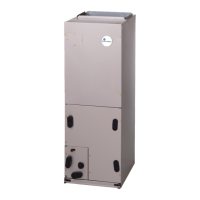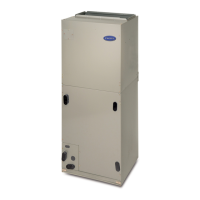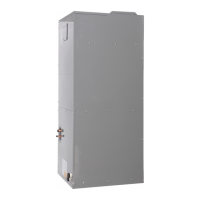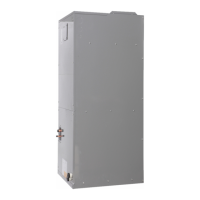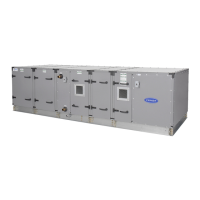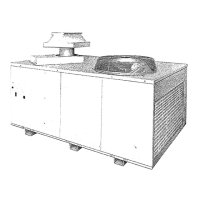18
• The next parameter (shown as OADP above) indicates the
sensor to enable the dehum mode. The type of sensor will
change depending on the unit configuration. Common con-
figurations include:
- Outdoor air dew point (OADP) vs supply air dew point
(SADP)
- Entering coil dew point (ECDP, with ECW) vs supply air
dew point (SADP)
- Supply air relative humidity (SARH)
• EN SP is the setpoint to enable dehumidification based on
the configuration above.
• The next parameter (shown as SADP) status indicates the
sensor to control cooling during dehum mode. The type of
sensor will change depending on the unit configuration.
Common configurations include:
- Supply air dew point (SADP)
- Supply air relative humidity (SARH)
• MOD SP is the setpoint to modulate the cooling system
(lead compressor).
• DH1 Mod will display the percentage of analog output
(UO-07) during dehumidification operation.
The Heating status screen shows the status and parameters the unit
heat source (if equipped). See Fig. 16.
Fig. 16 — Heating Status Screen
The following information may be shown on the Heating status
screen:
• Htg Mode status indicates that the conditions are met for
heating.
• The next parameter (shown as OAT above) indicates the
sensor to enable heating. The type of sensor will change
depending on the unit configuration. Common configura-
tions include:
- Outdoor air temperature (OAT)
- Entering coil air temperature (ECAT, with ECW)
• Htg En SP is the setpoint to enable heating. The setpoint is
adjustable on the Htg SP screen.
• SAT indicates the unit supply air temperature sensor,
which is used to modulate the heat source.
• Htg SAT SP is the supply air temperature setpoint for mod-
ulating the heat soource. The setpoint is adjustable on the
Htg SP screen.
• The Htg Mod will display the percentage of analog output
(UO-06).
• Clg to Htg Timer is a 10-minute timer for the cooling
mode to heating mode switchover.
• Indicator Lights:
- Htg EN will light when the heating enable condition is
met.
The Heat Pump 1 status screen shows the status and parameters
the heat pump units (62H and 62W only). Units with two refriger-
ant circuits (12+ tons) will also have a Heat Pump 2 status screen.
See Fig. 17.
Fig. 17 — Heat Pump 1 Status Screen
The following information may be shown on the Heat Pump 1 sta-
tus screen:
• RV Status will display Off when the heat pump unit is in
cooling mode and ON when the unit is in heat pump heat-
ing mode.
• Htg Mode status indicates that the conditions are met for
Heat pump heating.
• OAT indicates the sensor to enable compressor #1 or cir-
cuit #1.
• HP1 En SP is the setpoint to enable compressor #1 or cir-
cuit #1. The setpoint is adjustable on the HP1 SP screen.
• SAT indicates the sensor to modulate the compressor.
• MOD SP is the setpoint for modulating the compressor.
The setpoint is adjustable on the HP1 SP screen.
• The C1 Mod will display the percentage of analog output
(UO-07).
• MIN OFF Timer reflects the 5 minutes the compressor
must be off before restarting.
• MIN ON Timer reflects the 5 minutes the compressor must
be on before shutdown.
• Clg to Htg Timer is a 10-minute timer for the heating mode
to cooling mode switchover.
• Indicator Lights:
- HP1 EN will light when the enable conditions are met.
- Y1 will light when the UO-10 or compressor #1 is com-
manded on.
- CMP1 will light when the compressor #1 current sensor
show amperage.
- HPS1 and LPS1 will light in their normal state (N.C.).
When they go into alarm the light will go off.
- AHTG will light when the auxiliary heat is “on”, all
compressors will shut down.
- EHTG will light when the emergency heat is “on” and
the heat pump 1 shut down.
- WFS will light when there is water flow (used on 62W
units only).
- WFRZ will light when the water freeze stat is closed or
normal state (used on 62W units only).
- DR1 will light when the defrost relay is activated (used
on 62H units only).
Set Points Screens
The set points screen can be access form Home screen
(Home
Stp/DB) or Tech Setting screen (Setup
Setpoint/DB)
and contains links to all available component, safety, and mode set
point screens. See Fig. 18.

